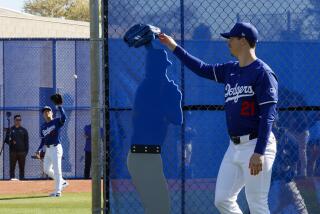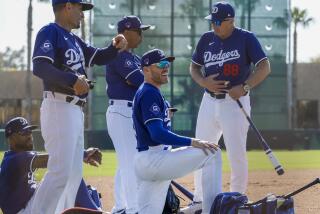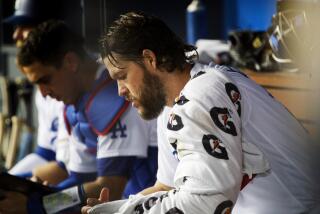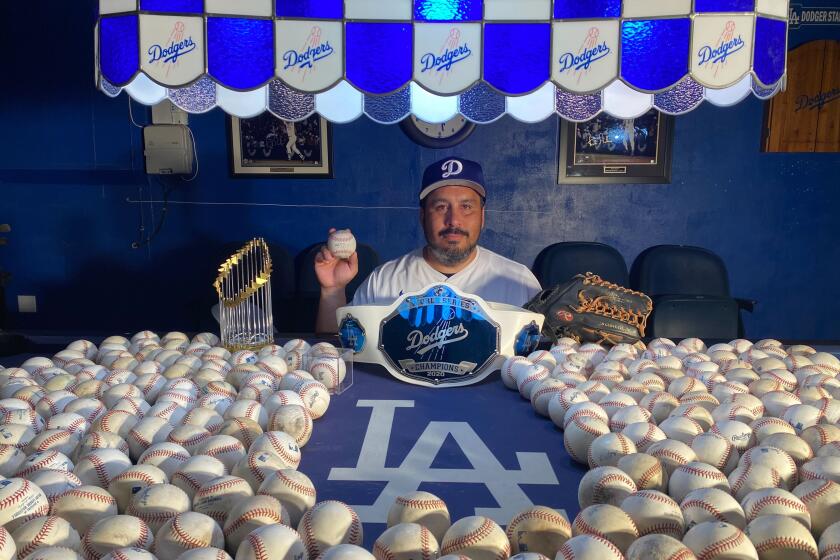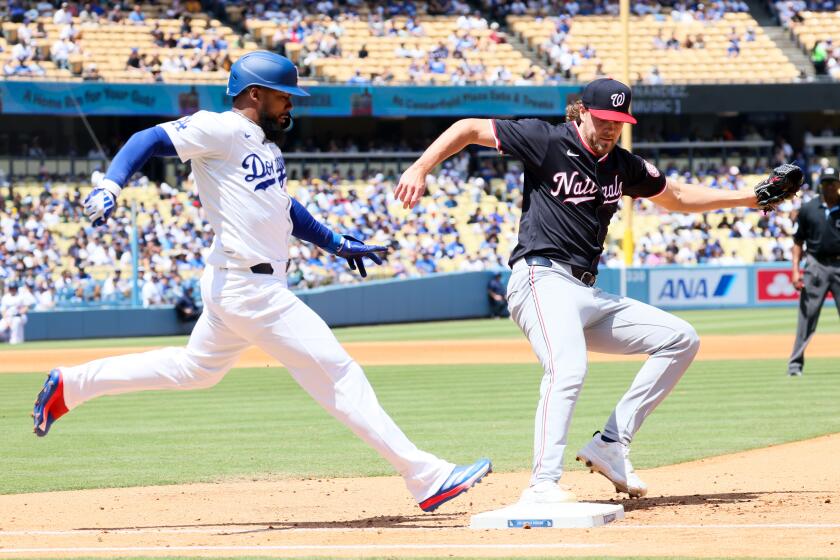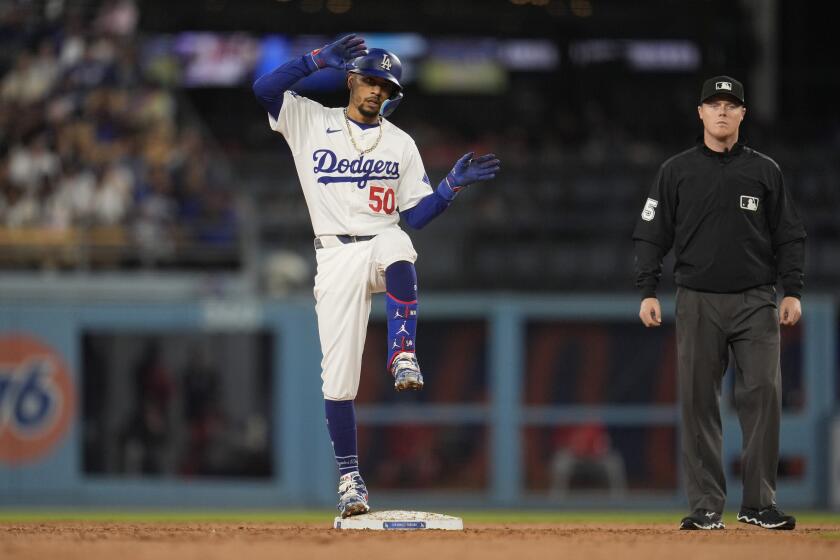Scott Kazmir looks to rebound in his second season with the Los Angeles Dodgers

Scott Kazmir signaled to catch the attention of Dodgers Manager Dave Roberts and pitching coach Rick Honeycutt. The rest of the pitchers were trudging a muddy path toward the clubhouse Sunday at Camelback Ranch. A gray sky threatened more rain, and Kazmir had already thrown live batting practice, but still he felt dissatisfied with his performance.
Roberts called back catcher Austin Barnes. Honeycutt instructed Barnes to set up a few feet in front of the plate. Barnes set a target as Kazmir attempted to purge the deficiencies he had developed in desperation during his brief, unsatisfying career as a Dodger.
For 10 minutes on the empty diamond, Kazmir threw. He murmured with his coaches in between pitches. The only exclamations came from his manager.
“That’s the one!” Roberts yelled after Kazmir finished a pitch with particular precision.
In his second season in Los Angeles, Kazmir does not exactly qualify as a reclamation project. At 33, he has been a productive pitcher in the majors for a decade. Only Kenta Maeda made more starts for the club last year. Kazmir won 10 games and made nine quality starts.
Yet his performance in 2016 still undershot expectations. By August, a season’s worth of injuries compounded to the point where he could no longer rotate his neck to the plate before he threw. Left off the playoffs, he finished with a 4.56 earned-run average, his worst since 2009.
Despite a shallow market for free-agent pitchers this winter, Kazmir declined to opt out of the final two years and $32 million of his contract. He chose to enter a crowded field for one of the final two spots in the Dodgers rotation. Kazmir will compete against Brandon McCarthy, Julio Urias, Alex Wood, Hyun-Jin Ryu, Brock Stewart and Ross Stripling.
Given his resume and a lack of minor-league options, Kazmir appears a favorite to make the club. But he is not interested in replicating the woes of 2016. Which is why he spent the winter receiving acupuncture to recover his flexibility, and why he intends to spend the spring re-syncing his delivery.
“He’s in as good a place as he’s been since he got here,” Roberts said.
The Dodgers had signed Kazmir in the wake of Zack Greinke’s signing with the Arizona Diamondbacks. He had overcome a slew of mid-career injuries to post a 3.54 ERA in his previous three seasons. He had hoped that physical infirmity was behind him. It was not.
The trouble started after his first start, a brisk, six-inning, one-hit gem against the San Diego Padres. In the days before his next outing, his left hip tightened up. The injury weakened his base when he threw, and he got pounded in his next three games.
With his hip impaired, Kazmir scrambled. Unable to produce velocity with his legs, he compensated by using his right shoulder as a lever. He viewed the decision as necessary, but it proved devastating. The discomfort traveled from his hip to his lower back to the trapezius muscles to his neck. The journey took months, but it compromised his performance.
“He had to end up using his upper body to pitch and got into some really bad habits,” Honeycutt said. “It was just a lot of negative things that happened, right up the body.”
Kazmir lost track of the number of examinations on his neck and back. The images showed inflammation but could not identify the source of it. There was no structural damage. So he kept taking the ball.
“Looking back on everything,” Kazmir said, “there was probably a lot of stuff that I would do differently, in hindsight.”
As Kazmir searched for an answer, his performance suffered. And he chafed at the restraints placed upon him. In his last 17 starts, he logged fewer than 100 pitches on 14 occasions. He reached the seventh inning only three times. Kazmir described the team’s caution about letting starting pitchers face hitters on a third trip through the batting order as “crazy frustrating.”
“But what are you going to do?” he said. “You’ve got to go out there and perform. That’s all you can really concentrate on.”
On multiple occasions, he visited Roberts’ office after games seeking clarity about his usage. Roberts understood Kazmir’s gripes. He saw a pitcher dealing with physical ailments, mechanical mis-alignments and a bumpy schedule created by an onslaught of injuries to the starting rotation. He advised Kazmir to “control what you can control,” Roberts said.
Kazmir’s body did not cooperate. The end was near Aug. 22 at Cincinnati, when Kazmir could not turn his head to the plate. His right shoulder was swollen and immobile. Sent to the disabled list, he saw his comeback short-circuited after he experienced back spasms in a one-inning outing Sept. 23. As the team entered the playoffs, Kazmir and McCarthy toiled through simulated games at Camelback Ranch up until the Dodgers were eliminated.
For Kazmir, his issues lingered into the off-season. In January, one of his trainers at Dynamic Sports Training in Houston connected him with Casey Ho, a chiropractor who specializes in acupuncture and was part of the medical staff for the U.S. taekwondo team at the Rio Olympics. Ho noticed that Kazmir utilized his quadriceps more than his gluteus muscles, reducing the flexibility of his hips.
Ho prescribed acupuncture and rounds of chiropractic adjustment. He talked to Kazmir about preventive exercises. The education opened Kazmir’s eyes. “He was just dumbfounded, really, because he didn’t know all those things worked together,” Ho said.
At Camelback Ranch, Kazmir abides by the daily suggestions from Ho. A more intriguing challenge involves sharpening his delivery, rediscovering how he pitched before the maladies of 2016.
And so Kazmir stood in the rain Sunday, Roberts and Honeycutt nearby. He threw until he felt content.
“He’s been extremely diligent in a lot of areas that he was having some issues,” Honeycutt said. “It was a lot of things that he tried to battle through that just hindered him from being able to do what he wanted to do. Now he’s trying to get back to where he feels good, and he can do the things that he feels more comfortable doing.”
Twitter: @McCulloughTimes
More to Read
Are you a true-blue fan?
Get our Dodgers Dugout newsletter for insights, news and much more.
You may occasionally receive promotional content from the Los Angeles Times.
